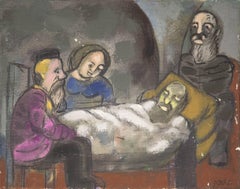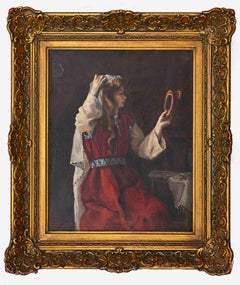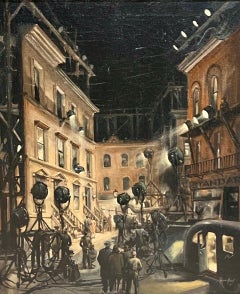Avraham Ofek Paintings
to
1
Overall Width
to
Overall Height
to
1
1
1
1
1
1
1
1
2
781
713
712
689
1
Artist: Avraham Ofek
Visiting the Sick, Modernist Israeli Oil Painting
By Avraham Ofek
Located in Surfside, FL
Genre: Avant-Garde
Subject: Figures
Medium: Oil
Surface: Canvas
Country: Israel
Dimensions: 13.25" x 16.25"
Dimensions w/Frame: 21.5" x 24.5"
Avraham Ofek (August 14, 1935 – January 13, 1990) was an Israeli sculptor, muralist, painter and printmaker.
Avraham Ofek was born in Burgas, Bulgaria. He immigrated to Israel in 1949, and he lived in Ein Hamifratz, a kibbutz near Haifa. He studied at the Academy of Fine Arts in Florence, as well as in Spain and in London, and later taught art in Jerusalem before being appointed head of the Art Department at the University of Haifa. He was one of the founders of the Leviathan group. He represented Israel at the Venice Biennale in 1972.
Avraham Ofek's early paintings of landscape were at both lyrical and rugged; later in his career the landscape was undefined and receded into the background. Near the end of his life, the landscape of Jerusalem became an important motif, reflecting loss and despair. Many of Ofek's landscapes convey a sense of alienation and solitude, as well as nostalgia for the city of his birth, Sofia.
His murals can be seen across Israel, notably at Kfar Uria and the Central Post Office Building (Jerusalem). His sculpture "The Binding of Isaac" is on view at the entrance to Safra Square.
In 1989 the Jerusalem Print...
Category
1970s Modern Avraham Ofek Paintings
Materials
Canvas, Oil
Related Items
A Young Oriental Woman Looking at the Mirror-Oil on Canvas - 19th Century
Located in Roma, IT
A young woman is an original modern artwork realized in Late 19th Century.
Mixed colored oil on canvas.
The artwork depicts a young woman with veil and mirror.
Unreadible signatur...
Category
19th Century Modern Avraham Ofek Paintings
Materials
Canvas, Oil
$1,430
H 16.15 in W 13.19 in D 0.04 in
Till the Clouds Roll By 1945 Frank Sinatra Mid Century Modern Hollywood Film WPA
By Richard Whorf
Located in New York, NY
Till the Clouds Roll By 1945 Frank Sinatra Mid Century Modern Hollywood Film WPA
TILL THE COULDS ROLL BY (Film Set), oil on canvas, 20 x 24 inches signed “Richard Whorf” lower right and signed and dated on the verso “R. Whorf/ Dec. 21, 1945. Frame by Hendenryk.
ABOUT THE PAINTING
This painting is from the collection of Barbara and Frank Sinatra, dated December 21, 1945 (just nine days after Frank Sinatra’s 30th birthday), and depicts the Metro-Goldwyn-Mayer Culver City backlot during the filming of Till the Clouds Roll By, the direction of the film having been taking over by Richard Whorf in December 1945. It is not presently clear if Whorf gave the Sinatras this painting as a gift, as the presence of the Dalzell Hatfield Galleries label on the verso indicates the painting may have been sourced there. Frank and Nancy Sinatra acquired a number of works from Dalzell Hatfield Galleries during the 1940’s, or perhaps they framed it for the couple.
Sinatra performed “Old Man River’ in the film. Sinatra and June Allyson are depicted in the center of the painting.
PROVENANCE From the Estate of Mrs. Nancy Sinatra; Dalzell Hatfield Galleries, Ambassador Hotel, Los Angeles.
An image of the Dalzell Hatfield label and the back of the original frame (which we replaced with a stunning Heydenrk frame) are attached.
Nancy Sinatra was Fran's first wife. Nancy Rose Barbato was 17 years old when she met Frank Sinatra, an 18-year-old singer from Hoboken, on the Jersey Shore in the summer of 1934. They married in 1939 at Our Lady of Sorrows Church in Jersey City where Frank gave Nancy a recording of a song dedicated to her titled "Our Love" as a wedding present. The young newlyweds lived and worked in New Jersey, where Frank worked as an unknown singing waiter and master of ceremonies at the Rustic Cabin while Nancy worked as a secretary at the American Type Founders.
His musical career took off after singing with big band leaders Harry James and Tommy Dorsey...
Category
1940s American Modern Avraham Ofek Paintings
Materials
Canvas, Oil
$75,000
H 31 in W 27 in D 2 in
Pere Creixams Spanish Woman, Oil on Canvas
By Pere Créixams Picó
Located in Saint Amans des cots, FR
Oil on canvas by Pere Creixams Pico (1893-1965), School of Paris, ca.1920. Beautiful Spanish woman. Provenance: Charpentier Gallery, 76 rue du Faubourg Saint Honore, Paris (Sotheby's...
Category
1920s Modern Avraham Ofek Paintings
Materials
Canvas, Oil
$4,000
H 24.81 in W 19.49 in D 2.96 in
Neighbors
By Norman Barr
Located in Los Angeles, CA
Neighbors, 1939, oil on canvas, signed and dated lower right, 22 x 26 inches
Norman Barr was an American Scene painter and muralist known for his poignant depictions of working-clas...
Category
1930s American Modern Avraham Ofek Paintings
Materials
Canvas, Oil
"One Thousand Words" - Surreal Figurative
Located in Soquel, CA
Bold figurative work by Richard Cronin (American, b. 1952). Two figures stand on a patio, turned away from each other. The figures and scene are rendere...
Category
1970s American Modern Avraham Ofek Paintings
Materials
Canvas, Oil
$2,040 Sale Price
20% Off
H 48 in W 48 in D 1 in
A Laborer Resting
By Robert Gilbert
Located in Los Angeles, CA
A Laborer Resting, 1930, oil on canvas, signed and dated lower center, 36 x 30 inches, inscribed verso “July – 1930 / Title – A Laborer Resting / Artist – Robert Gilbert / Price - $2...
Category
1930s American Modern Avraham Ofek Paintings
Materials
Canvas, Oil
"Drama Teacher" 1938 WPA Mid 20th Century American Theatre Surrealism Modernism
By Leon Bibel
Located in New York, NY
"Drama Teacher" 1938 WPA Mid 20th Century American Theatre Surrealism Modernism. 30 x 24 inches. Oil on Canvas. Signed land dated ’38 lower left.
The photograph in the listing depicts the artist's friend who taught drama and about whom the painting is based
Painter, printmaker and sculptor, Leon Bibel was born in San Francisco in 1913. He trained at the California School of Fine Arts and received a scholarship to study under the German Impressionist Maria Riedelstein. He worked in collaboration with Bernard Zackheim, a student of Diego Rivera, to create frescoes for the San Francisco Jewish Community Center and the University of California Medical School.
In 1936 Bibel moved from California to join the Federal Art Project at Harlem Art...
Category
1930s American Modern Avraham Ofek Paintings
Materials
Canvas, Oil
"Audience" Mid 20th Century American Figurative Theatre Performance Contemporary
By Leon Bibel
Located in New York, NY
"Audience" Mid 20th Century American Figurative Theatre Performance Contemporary
Leon Bibel (1912 - 1995) "The Audience," 52 ½ x 41 ¼ inches. Oil on canvas, c. 1963. Signed lower right. Framed.
BIO
Painter, printmaker and sculptor, Leon Bibel was born in San Francisco in 1913. He trained at the California School of Fine Arts and received a scholarship to study under the German Impressionist Maria Riedelstein. He worked in collaboration with Bernard Zackheim, a student of Diego Rivera, to create frescoes for the San Francisco Jewish Community Center and the University of California Medical School.
In 1936 Bibel moved from California to join the Federal Art Project at Harlem Art...
Category
1960s American Modern Avraham Ofek Paintings
Materials
Canvas, Oil
$24,500
H 54 in W 44 in D 2 in
"Concert" Early 20th Century WPA Modernism American City Landscape Scene Ashcan
By Michael Loew
Located in New York, NY
"Concert" Early 20th Century WPA Modernism American City Landscape Scene Ashcan
The size of the canvas 28 3/4 x 43 1/4 inches. The painting comes directly from the artist's estate. It is signed lower right as well as signed, titled and dated verso.
We have available more than two dozen paintings and works on paper from the 1930s - 80s that come directly from the Loew estate.
BIO
Michael Loew (1907 – 1985) was the son of a New York City baker. After high school, he was an apprentice to a stained-glass maker, and from 1926-1929, he studied at the Art Students League. In 1929, he traveled to Paris, North Africa, Germany, and Italy with a group of artists. When he returned to New York City in 1931, the Great Depression hit Loew unexpectedly, and for the next two years he paid his apartment rent with his paintings. In 1935, he found work with the WPA where he painted murals and partnered up with longtime friend Willem de Kooning in 1939 on a mural for the Hall of Pharmacy at the New York World’s Fair. Their friendship lasted for the rest of their lives. In the mid-30’s he painted in Mexico and the Yucatán documenting the construction of a U.S. Naval airbase on Tinian Island. It was from this airbase that the Enola...
Category
1920s American Modern Avraham Ofek Paintings
Materials
Canvas, Oil
'Tolly No. 3' by B. Krigstein - Figurative Female Nude Model - Ashcan School
Located in Carmel, CA
No description provided
Category
20th Century Modern Avraham Ofek Paintings
Materials
Canvas, Oil
$4,650 Sale Price
25% Off
H 32 in W 28 in D 1 in
Rooftop Bathers (Untitled)
Located in Los Angeles, CA
Rooftop Bathers (Untitled), c. 1940s, oil on canvas, 22 x 32 inches, signed lower right
Betty Waldo Parish gives us a delightful slice of life in 1940s New York, as we see a coupl...
Category
1940s American Modern Avraham Ofek Paintings
Materials
Canvas, Oil
Day at the Park - Surreal Figurative
Located in Soquel, CA
Bold figurative work by Richard Cronin (American, b. 1952). Two figures are at the edge of the sea, one of which is seated and holding two beach balls. ...
Category
1970s American Modern Avraham Ofek Paintings
Materials
Canvas, Oil
$1,720 Sale Price
20% Off
H 48 in W 36 in D 1 in
Previously Available Items
Visiting the Sick, Modernist Israeli Oil Painting
By Avraham Ofek
Located in Surfside, FL
Genre: Avant-Garde
Subject: Figures
Medium: Oil
Surface: Canvas
Country: Israel
Dimensions: 13.25" x 16.25"
Dimensions w/Frame: 21.5" x 24.5"
Avraham Ofek (August 14, 1935 – Januar...
Category
1970s Modern Avraham Ofek Paintings
Materials
Canvas, Oil
Avraham Ofek paintings for sale on 1stDibs.
Find a wide variety of authentic Avraham Ofek paintings available for sale on 1stDibs. You can also browse by medium to find art by Avraham Ofek in canvas, fabric, oil paint and more. Much of the original work by this artist or collective was created during the 1970s and is mostly associated with the modern style. Not every interior allows for large Avraham Ofek paintings, so small editions measuring 25 inches across are available. Customers who are interested in this artist might also find the work of Moshe Katz, David Azuz, and Patricia Gren Hayes. Avraham Ofek paintings prices can differ depending upon medium, time period and other attributes. On 1stDibs, the price for these items starts at $2,000 and tops out at $2,000, while the average work can sell for $2,000.



